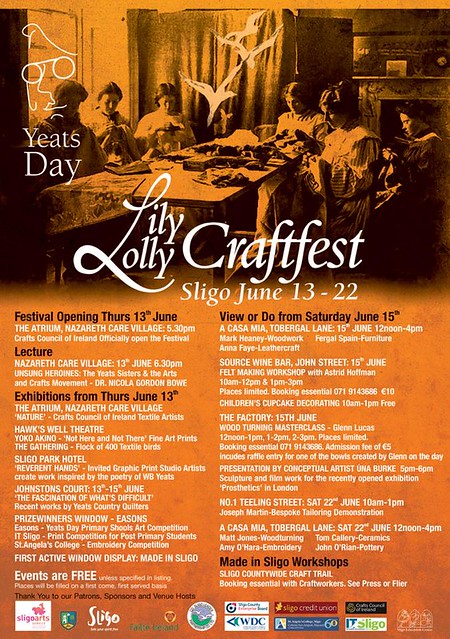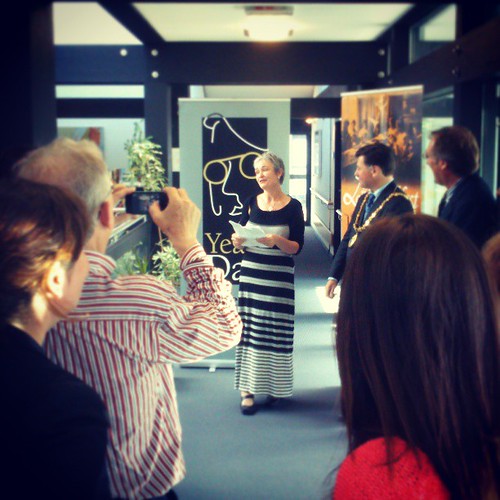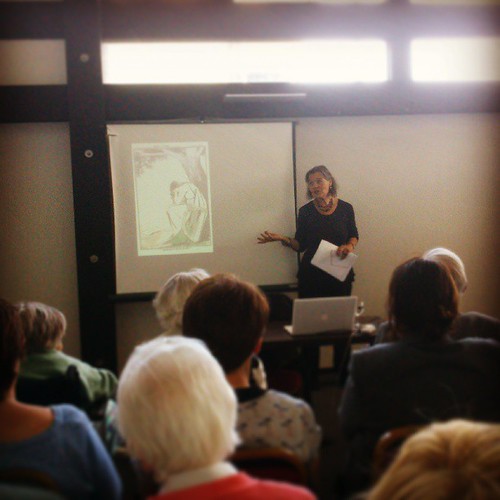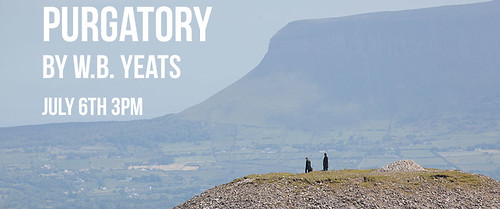The Tread Softly festival is an initative that seeks to promote Sligo's Yeats legacy as a unique cultural visitor attraction. "The Land of Heart's Desire" has long held appeal for devotees of the poet Yeats, but the story of the Yeats family has its roots in Sligo's rich landscape.
The short video above shows the highlights of last year's first 'Tread Softly' festival. From 2:45 onward you can hear me speak! Last year I gave tours of the John and Jack B. Yeats 'Father and Son' exhibition at The Model gallery. This year I will again be giving a couple of public tours of the current Jack B. Yeats' exhibition 'Enter the Clowns: The Circus as Metaphor'.
Though not a new concept by any means, cultural tourism has gained a lot of mileage in recent years, particularly amongst regional tourism groups striving to make economic gains by utilising their unique local cultural heritage. And who can blame them? Personally, I have seen a vibrant revival in Sligo's arts and culture scene, since I returned a little over a year ago (after being abroad for almost 2 years). Much progress has been made to promote Sligo as a cultural destination, for the benefit of its locals and visitors alike. Cultural tourism also takes place at a local level, with the advent of facebook, many groups promoting local history and encouraging engagement from their members have sprung up. Some recent festivals promoting their area's unique cultural attractions include the Liberties Festival and Happy Days - Enniskillen's International Beckett Festival.
What is Cultural Tourism? Cultural tourism is about understanding the collective cultural offer of a destination, matching that offer to (and connecting with) the 'wraparound' industries (food, drink, hotels, shops and so on) and making sure that it's all packaged in a way that is meaningful to the consumer. (Helen Palmer, 'Why cultural tourism is not a quick fix', The Guardian, April 15 2013)

Recently, in acknowledgement of this, the North-West Craftfest was rebranded as the Lily Lolly Craft Fest. The aim is to commemorate the legacy of the lesser celebrated Yeats sisters, who were pioneering craftswomen in their own right. They were at the forefront of the Irish Arts and Crafts movement, founding the Dun Emer Guild in 1902 with Evelyn Gleeson in Dundrum, Co. Dublin. You can read the article I wrote on the sisters for the Women's Museum of Ireland here.



1. Martina Hamilton, owner and designer at the Cat and the Moon craft boutique and jewellery shop, and curator of the Hamilton Gallery, officially launching the Lily Lolly Craftfest on June 13th.
2. Celebrated academic and expert on the Irish arts and crafts movement, Nicola Gordon-Bowe, delivering a talk on the legacy of the Yeats' sisters, at the Lily Lolly Fest.
The Lily Lolly Craft fest coincided with Yeats Day 2013. Yeats Day is envisioned to be Sligo's version of Bloomsday (June 16th) or Shakespeare's Birthday (April 20th).These are grand shoes to fill. Expectations are hig. The Lily and Lolly festival had the support of local businesses and crafts people. My festival highlights include the Nicola Gordon-Bowe lecture, Una Burke's talk and an embroidery workshop with Amy O'Hara of Dumore Embroidery. These events certainly played close to the Lily and Lolly legacy, by promoting a body of work by by local craftswomen, and the festival was launched with a talk by Nicola Gordon-Bowe, an authority on the Yeats sisters.

My criticism would lie with the marketing of these events, particularly the digital strategy. While the leaflets and poster designs were of particularly high quality. There appeared to very little engagement with Sligo's online community, or the online craft community at large. Una Burke's talk was a total revelation to me, but was so poorly marketed that the attendance for what was an outstanding afternoon was less than it should have been. This lady's career is on the rise, she has designed for Lady Gaga and has exhibited in prominent London galleries! Her inclusion in the event line-up should have been shouted from the rooftops, at least the virtual ones! The failure of the digital strategy to provide a suitable platform for the local businesses that participated meant that some events didn't receive as much attention as they might have done. In this globalised world, cultural organisations cannot afford to ignore the digital sphere when working in cultural tourism.

Looking at organisations finding their soft spot in engaging the cultural and digital sphere ... one of the more unique places I have gone to see a performance, Sligo's Blue Raincoats Theatre company staged a performance of W.B. Yeats' play Purgatory at the summit of Knocknerea mountain, at the base of Queen Maeve's cairn. Incentives like this promote Sligo as a unique cultural destination, a place where magical things happen, such as a contemporary theatre company staging a play by one of the counties famous sons, at the summit of an ancient mountain.

The 'Sligo Who Knew?' campaign turns to social media to unearth the counties hidden gems and to promote Sligo as a 'staycation' destination, being only a 2 and a half hours drive from Dublin. Using the #sligowhoknew hashtag Sligo businesses, cultural centres, selected digital ambassadors, tourists and Sligo tweeters can share the hidden corners of Sligo, from their unique point of view! You can see all the tagged content from all social networks on the #sligowhoknew tagboard. It is probably one of the most forward thinking digital tourism strategies in Ireland at the moment! As a Sligo person, I too play a part in this dialogue, as the press release highlights - "Locals Become Proud Ambassadors of their Homeland".
"… Sligo was a different habitation. A small and beautiful town situated almost at the western edge of Europe, it was bounded by green fields, mountains, and the sea, and its narow streets were lined with small shops. At the quays there were boats loading and unloading, and sailors with stories that made the world seem “full of monsters and marvels”. Over the town to the west loomed the mountain Knocknarea, on its flat top an enormous mound supposed to contain the remains of Queen Maeve; to the north beyond Drumcliff stood Ben Bulben, the long stone outcrop ending in a massive, razor-sharp edge. With its mists and changing colours, its ancient mysterious mounds and dolmens, Sligo was a place where one could easily believe in a world of magic.”
'Prodigal Father: The Life of John Butler Yeats (1839-1922)', William M. Murphy,
(London: Cornell University Press, 1978)
Sligo and its enchanting landscape was a constant source of inspiration for all of the Yeats siblings. Prompted by their father's inability to secure and retain commissions they entered into artistic professions with the intention of earning a living, with the explicit aim of utilising their creative talent into something productive and profitable. These recent festivals promote the Yeats family legacy and seek to place it at the centre of the cultural, historical and physical spirit of Sligo, inspiring a new generation to be inspired by Sligo and its creative traditions; just as the Yeats family once were.
See more:
Cultural Tourism Ireland
Museums connecting cultural tourists: more substance over style, please
Helen Palmer, 'Why cultural tourism is not a quick fix', The Guardian, April 15 2013
‘Sligo – Who Knew?’ Turns To Social Media To Unearth Hidden Gems
Tread Softly ... A Season of Yeats festival
Treading softly in Sligo (Irish Examiner, July 24 2013)

wonderful post lovely information really enjoyed your post thanks
ReplyDeletevintage clothing